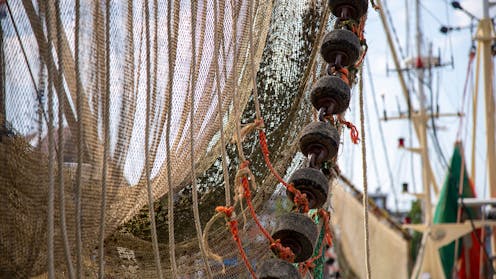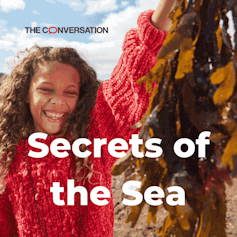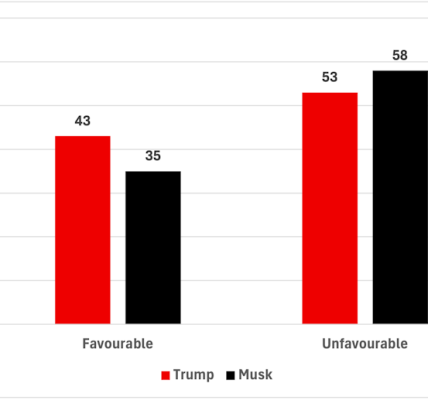David Attenborough’s Ocean reveals how bottom trawling is hurting sealife in horrifying detail
A bottom trawl net hanging to dry in the harbour of Harlingen in the Netherlands, showing the rockhopper rollers on the footrope that contacts the seabed. 365 Focus Photography/Shutterstock
In one of the most powerful scenes of Sir David Attenborough’s new film Ocean, the audience sees industrial fishing from a fish’s perspective.
Confronting a bottom trawl net as it thunders across the seabed, terrified fish scatter in desperate but futile attempts to escape the vast net swallowing them. The heavy chain that holds the trawl down sweeps away sponges, corals, seagrass and other seabed life, leaving behind utter devastation.
Attenborough’s latest nature documentary is a visually magnificent and highly personal meditation on the relationship humans have with the sea. It is the most important part of our world, he says. But we have taken it for granted.
A century of intensifying and destructive fishing has culminated in bottom trawl nets, some as big as cathedrals and weighing many tonnes, being towed along the seabed to catch fish. To allow them to fish more effectively in areas of rough seabed, which is where most marine life is found, fishers in the 1920s invented “rock-hopper” gear: rollers placed along the foot rope that touches the bottom, allowing the net to bounce over obstacles.
This innovation followed the trajectory of many fishing methods, which was to become more destructive over time to sustain the size of catches in the face of declining fish stocks.
Trawler nets are designed to gobble up marine life indiscriminately.
Anney_Lier/Shutterstock
Shellfish dredging, another fishing method that destroys as it catches, is shown in a second horrifying scene. To catch scallops, steel dredges armed with spikes (imagine the harrows farmers use to break up soil on ploughed fields) drag along the seabed, smashing and pummelling everything. In minutes, seabed life of astonishing diversity and beauty is erased.
Together, Attenborough explains, bottom trawling and dredging wreak their havoc across an area of seabed larger than the Amazon rainforest every year.
Attenborough invites viewers to wonder how on Earth these fishing methods are still allowed when the damage is so obvious. Viewers may be even more surprised, and very probably angry, to learn that most marine protected areas in Europe, and indeed worldwide, permit bottom trawling and dredging within their boundaries.
To understand why this is the case, we have to go back in time.
A medieval practice
We know from the parliamentary records of Edward III in 1376 that fishers in southern England were practising bottom trawling as far back as the 1300s. Long-held traditions are hard to change, even when there is irrefutable evidence that they cause harm.
It is telling, however, that this early description of trawling is a petition urging the king to ban the method for its reckless destruction of habitat and waste of fish.
Nevertheless, these fisheries expanded because trawling was an efficient means of landing huge quantities of fish. Trawling’s success came at the expense of what we call marine animal forests, habitats built by animals like oysters, horse mussels and sponges – all swept away to leave behind vacant shifting sands, mud and gravel that predominate over vast swaths of seafloor today.
A recent estimate has suggested that oyster reefs once covered at least 17,000 square kilometres of European seas – an area the size of Northern Ireland. All of this was gone by the beginning of the 20th century. This ecosystem cannot recover until it is offered protection from trawling and dredging. So, why haven’t we protected it?
Degraded habitats, profoundly altered by trawling, were what scientists and then conservationists found when they first ventured below water after the invention of scuba diving in the mid-20th century. These early submarine explorers mistook them for natural and wild, failing to see the role industrial fishing had played in their creation.
Being now occupied almost exclusively by creatures used to the passage of trawls – animals that live fast and die young like worms, prawns and whelks – these habitats were labelled as resilient, and not in need of protection.
This warped perspective fooled us into thinking that marine protected areas left open to bottom trawling would be fine. In the few cases where protected areas exclude trawling, like around the Isle of Arran in western Scotland, the swift resurgence of seabed life has revealed how wrong this assumption was.
In only five years, sea-moss, sea-nettles, scallops and brittle stars have reoccupied the seafloor, a transformation that is nevertheless just the beginning of a recovery that will carry on for decades.
Seabeds protected from trawls and dredges can rebound, like this one off the Isle of Arran. It offers a glimpse of what existed before industrial fisheries.
Henley Spiers/Blue Marine Foundation
Giving up the trawl and dredge does not mean an end to fishing, as the film explains. In fact, recovering fish populations in protected areas replenish those in fishing grounds nearby, leading to better and more sustainable catches.
Calling time on destructive fishing
Perhaps now, at last, the writing is on the wall for bottom trawling and dredging, because they do a more insidious form of damage we have only recently become fully aware of. The ocean floor is one of the planet’s largest carbon stores. A snowfall of sinking organic matter and sediment accumulates on the seabed, where the carbon it contains is buried for thousands of years.
Left undisturbed, this carbon is out of harm’s way. But when churned up by the passage of trawls and dredges, some is turned back into CO₂, some of which will end up back in the atmosphere.
The magnitude of these seabed carbon emissions, and their role in climate change, is hotly debated. Getting more reliable estimates is the mission of a five-year project I lead, the Convex Seascape Survey. One thing is already clear from our research, however: there are places underwater – like peat bogs or permafrost on land – that we should not disturb because they harbour immense quantities of carbon.
Ironically, these muddy basins have in the past few decades become some of the most intensively fished places in the sea because they are home to valuable prawns, which are among the few species still able to support viable fisheries.
Any country serious about meeting net zero in time to prevent dangerous climate change must act swiftly to protect its seabed carbon stores. And any country serious about ocean conservation knows that marine protected areas are useless if they don’t exclude trawling and dredging.
David Attenborough, Silverback Films and the Open Planet Studios team have brought these truths to a mass audience, leaving no space for further evasion and denial. What we need now is action.
Don’t have time to read about climate change as much as you’d like?
Get a weekly roundup in your inbox instead. Every Wednesday, The Conversation’s environment editor writes Imagine, a short email that goes a little deeper into just one climate issue. Join the 45,000+ readers who’ve subscribed so far.
Callum Roberts receives funding from Convex, the Natural Environment Research Council and the European Research Council. He is on the board of Nekton and Maldives Coral Institute and sits on the Minderoo Natural Ecosystems advisory panel, the Bertarelli Ocean Legacy Science advisory board and the CORDAP science advisory panel.




